|
Celluloid,
Chinese laundries and racism |
||
|
When I was in Holly Lodge Grammar School for Boys, so many years ago, I developed an interest in chemistry. My brother and I had a chemistry set that we'd add to whenever we could. And it was pretty easy to do so, because at the time there weren't a lot of restrictive rules about what a shopkeeper could sell to two kids. It wouldn't be hard to imagine the kind of experiments we were interested in. Yes, those that produced an explosion. There were two main suppliers of the necessary chemicals in Smethwick: a garden shop on the Oldbury Road and the pharmacy, on the opposite side of the road, owned by Mr. Carr BSc, MRPS. For gunpowder, the sulphur and charcoal were available at the garden shop as fertilizers, but for the potassium nitrate you had to go to the pharmacy. Mixed together, and the blue touch paper lit, they provided a dramatic and satisfying explosion for our young ears! Where we were less successful was in the production of nitrocellulose. Probably the difficulty was in the relatively low concentration of nitric acid available to us from Mr Carr. It was possible to believe that our nitrocellulose, put on a large steel vice, and then hit with a heavy hammer, produced a small explosion, but it was probably only in our imagination. But nitrocellulose has a history that is not exclusively related to its use as a powerful explosive. There is also its use, when mixed with camphor, to create Celluloid. In fact what we know as 'Celluloid' was created by Alexander Parkes from Birmingham. He named it 'Parkesine' in 1856, before it was finally registered as Celluloid in 1870. Celluloid was the first plastic created and is easily moulded. It was initially used as a cheaper substitute for ivory, as it was similar in colour. Later, it was used for photographic plates and in the film industry before the introduction of (non-flammable) acetate security film in the 1950s. So it has an important presence in our artistic and social history. Since celluloid is highly flammable, it has however long since been replaced by other plastics with the odd exception of, for example, ping-pong balls and guitar picks. So don't smoke when you're playing table-tennis. Fashion, but also class and racism, make a major appearance in the shirt fronts, collars and shirt cuffs made of celluloid. The association between the whiteness of clothes and social status has a history that begins in the sixteenth century with the discovery of starch in 1554. Maintaining whiteness required constant washing, and so 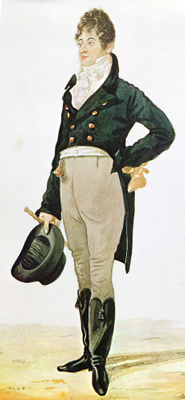 there
was a price to pay to keep one's appearance
fashionable, affordable only by the
wealthier classes. The white
collar, which would become a sign of
professionalism in the late nineteenth
century, had already been a sign of
refinement in the late eighteenth
century among men of the
upper middle class. Back in the early
nineteenth century, the English dandy
George "Beau" Brummell promoted the use
of white clothing as an indication of
status. Whilst the collar and cuff
gradually replaced the ruff, and lace at
the wrists, the link between the
whiteness of men's clothing and status
continued. Which meant that laundries
were profitable businesses, especially
in the second half of the 19th century. there
was a price to pay to keep one's appearance
fashionable, affordable only by the
wealthier classes. The white
collar, which would become a sign of
professionalism in the late nineteenth
century, had already been a sign of
refinement in the late eighteenth
century among men of the
upper middle class. Back in the early
nineteenth century, the English dandy
George "Beau" Brummell promoted the use
of white clothing as an indication of
status. Whilst the collar and cuff
gradually replaced the ruff, and lace at
the wrists, the link between the
whiteness of men's clothing and status
continued. Which meant that laundries
were profitable businesses, especially
in the second half of the 19th century.
Although, in general, there was a variety of people who took advantage of their clients’ desire to have clean clothes without the hard work, a racial peculiarity appeared in the West of the United States in the 19th century - the laundry business became dominated by the Chinese. This was in turn due to racial discrimination by Euro-Americans in prohibiting their participation in jobs other than mining and railway construction. In fact, many Americans were strongly against the Chinese presence in America and there were often attempts to boycott their products and services, but without success. Like today it was a question of price. Mark Twain noted that for the Chinese laundry in Nevada "the price for washing was $2.50 per dozen, and therefore rather cheaper than what laundries run by whites needed to charge at the time.” But all this would be the subject of a serious attack when celluloid made its appearance. Typically men’s shirts had detachable fronts, collars and cuffs, and all needed to be starched to conform to the fashion of the time. But celluloid made all this redundant because it did not become dirty easily and was, by nature, rigid. For the vast majority who needed to maintain a certain style, but without servants to do things for them, this was a significant saving. 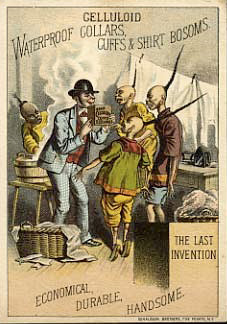 We can see from the
trade cards distributed at the time on behalf
of the Celluloid Company, that the
unpopularity of the Chinese was a major point
in the sale of these new products. In fact
calling them 'trade cards' implies something
fairly refined, when in fact they were
examples of the sort of scurrilous advertising
typical of the lack of regulation at that
time. While there were cards that represented
various other themes, like circus acts, the
most common subject involved the parody of
upset Chinese washerwomen. For example, there
is a card depicting a travelling salesman
displaying his new products of celluloid
cuffs, collars and shirt fronts, leaving the
assembled Chinese washerwomen in a state of
shock, with their black pigtails standing on
end. We can see from the
trade cards distributed at the time on behalf
of the Celluloid Company, that the
unpopularity of the Chinese was a major point
in the sale of these new products. In fact
calling them 'trade cards' implies something
fairly refined, when in fact they were
examples of the sort of scurrilous advertising
typical of the lack of regulation at that
time. While there were cards that represented
various other themes, like circus acts, the
most common subject involved the parody of
upset Chinese washerwomen. For example, there
is a card depicting a travelling salesman
displaying his new products of celluloid
cuffs, collars and shirt fronts, leaving the
assembled Chinese washerwomen in a state of
shock, with their black pigtails standing on
end. 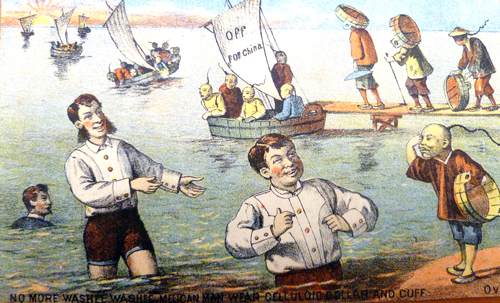 Among
all these trade cards, stereotyping the
Chinese, even their washing accessories
are used as props for the wished for
disappearance of the Chinese: their
washing tubs are converted into boats to
return to Asia in a card entitled "Off for
China". Euro-americans are shown as big
healthy people whilst the chinese are
shown almost as pygmies. Another feature of these cards is
the incorporation of 'Chinese' English into
the text. Again, in "Off for China", the
Chinese response to the new collars and cuffs
of the American man appears at the bottom of
the card: "No more washee washee, melican man
wear celluloid collar and cuff". The
translation of the Chinese accent underlines
their very alien status in the Anglo-American
culture of that time. Among
all these trade cards, stereotyping the
Chinese, even their washing accessories
are used as props for the wished for
disappearance of the Chinese: their
washing tubs are converted into boats to
return to Asia in a card entitled "Off for
China". Euro-americans are shown as big
healthy people whilst the chinese are
shown almost as pygmies. Another feature of these cards is
the incorporation of 'Chinese' English into
the text. Again, in "Off for China", the
Chinese response to the new collars and cuffs
of the American man appears at the bottom of
the card: "No more washee washee, melican man
wear celluloid collar and cuff". The
translation of the Chinese accent underlines
their very alien status in the Anglo-American
culture of that time.But why were the Chinese so unpopular? At that same time the 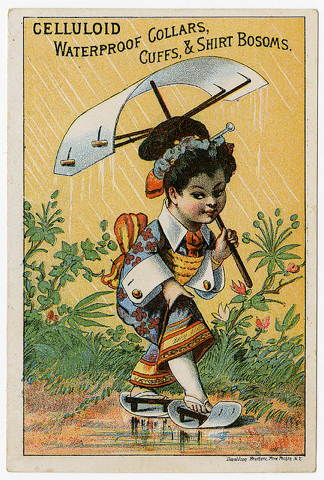 Japanese didn't suffer from
the same problem. In fact, as can be
seen from another card showing a pretty
young Japanese girl dressed in celluloid
collars and cuffs, they were seen as
people of a relatively high social
standing. Japanese art was particularly
popular. But when their "No More Chinese
Cheap Labor" trading card was produced by
the Celluloid Company, discrimination
against the Chinese in America was
'coincidentally' at its peak. Japanese didn't suffer from
the same problem. In fact, as can be
seen from another card showing a pretty
young Japanese girl dressed in celluloid
collars and cuffs, they were seen as
people of a relatively high social
standing. Japanese art was particularly
popular. But when their "No More Chinese
Cheap Labor" trading card was produced by
the Celluloid Company, discrimination
against the Chinese in America was
'coincidentally' at its peak. Chinese immigration had signficantly increased. The Chinese accounted for 25% of California's working population in 1870. Riots against them broke out along the Pacific coast in 1870, and the 'Workingmen' party pledged to get rid of Chinese labour "as soon as possible". Around the same time, factories in the north-east also began hiring Chinese workers, often as strike-breakers, so creating further racial tension. 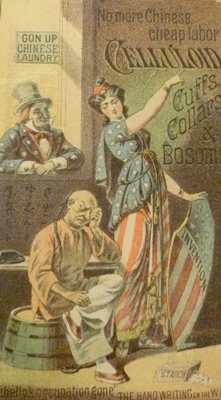 In
1883, a statute was passed prohibiting any
more Chinese from entering the country and
barring those already there from applying
for citizenship. Most people believed that
the cheap labour of the Chinese was a
serious economic problem for the United
States. The Celluloid Company decided to
use the then political climate of opinion
in the image they used on their business
card - "No More Chinese Cheap Labor". And,
in fact, the card looks more like a
political cartoon than a product promotion
tool. It has 'Lady Invention',
dressed in the American flag, telling them
to go, with Uncle Sam in the background
looking on approvingly. In
1883, a statute was passed prohibiting any
more Chinese from entering the country and
barring those already there from applying
for citizenship. Most people believed that
the cheap labour of the Chinese was a
serious economic problem for the United
States. The Celluloid Company decided to
use the then political climate of opinion
in the image they used on their business
card - "No More Chinese Cheap Labor". And,
in fact, the card looks more like a
political cartoon than a product promotion
tool. It has 'Lady Invention',
dressed in the American flag, telling them
to go, with Uncle Sam in the background
looking on approvingly.So then what lesson can we draw from this? Maybe it is that nitrocellulose is a powerful explosive but, when mixed with camphor to create Celluloid, it becomes an agent for social change even more powerful. Paul Buckingham 26 May 2020 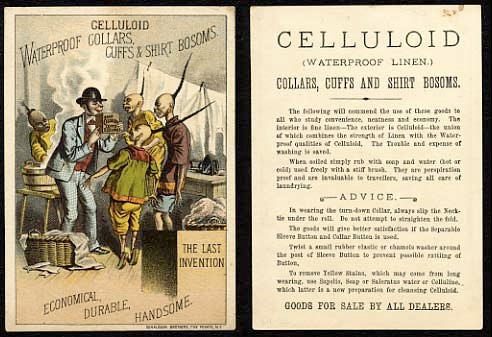 |
||
|
|